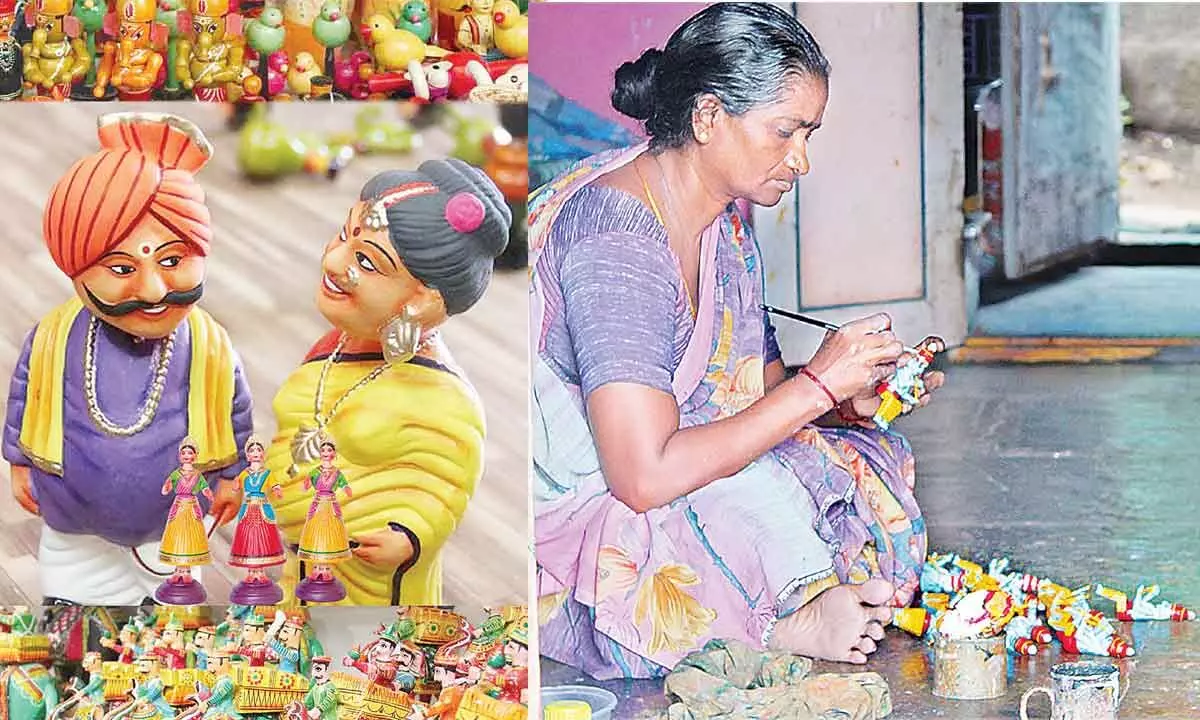Live
- Job scam: No High Court bail for Partha
- Joint teams from AP, TG destroy illicit liquor
- Refusing medical aid to sexual, acid attack survivors an offence
- TTD Parakamani Theft Case: Fresh row as board member seeks probe
- People struggling with rising prices: Rahul
- Santa cap on Annamayya statue sparks tension
- Speed up Bhogapuram airport works: CS to officials
- Demand up for Amit Shah’s dismissal
- APSFL sacks 410 staff with immediate effect
- Integrity of poll process eroding
Just In
Kondapalli toys-A gift to the world of art


Bright-hued wooden toys, filled with life and splendour, that radiate our nation's glory from shelves and platforms on regular days and festivals alike – Kondapalli toys are surely one of India's finest, richest, and brightest art forms.
Bright-hued wooden toys, filled with life and splendour, that radiate our nation's glory from shelves and platforms on regular days and festivals alike – Kondapalli toys are surely one of India's finest, richest, and brightest art forms. Historically used both for gifting and owning, Kondapalli toys, given their nature of use, were never restricted only to the kids. They were, in fact, mostly owned by the adults who saw it both as a style statement and a metaphor for their child-like enthusiasm towards life.
Kondapalli toys take their name from the suburban town of Vijayawada city – Kondapalli, of Krishna District in Andhra Pradesh. Zooming in further into the Kondapalli town, Bommala ("Toys" in Telugu) Colony is where the real action of crafting takes place. While we see these toys even today, it is fascinating to note that the art of Kondapalli toys is 400 years old and it literally stood the test of time, changing trends and several invasions. On that resilient note, what seemed like a bleak future for these toys, found a new breath of life in 2007, when these became the first handmade toys to have received the Geographical Indication (GI) tag, thereby verifying their status and importance that was long pending.
Seemingly simple on the outside, Kondapalli toys are made of locally sourced softwood (Tella Poniki) found in the surrounding hills, that are later sculpted with painstaking efforts by perseverant artisans who dedicated their lives to pursuing and preserving this art form. These artisans belong to a community called AryaKshatriyas, who are originally toymakers and wood-sculptors by profession. The legend goes, that this community, charts its lineage to sage Mukta Rishi, who was blessed by Lord Shiva Himself to pursue his inherent expertise in art and toy-making. Furthermore, many of the workers are also migrants from Jaipur and Koraput (of Rajasthan and Odisha respectively) who claimed their lineage to Mukta Rishi and received patronage under the then King of the Kondapalli fort.
In an age of complicated machine-made legos and environmentally harmful plastic toys, Kondapalli toys continue to carve out their niche given their rootedness in the storytelling of rural life and epics, sustainability, as well as the complexity in the process of making these toys too. First, the different parts of the toy are sculpted carefully with precision, and then they are all assembled to beautifully form the final toy. Now bright colours (made of vegetable dyes, water, and oil paints) await these assembled toys, to add a lot more character, life, and detail. As for the brushes that are used for painting, soft and thin paint brushes made of goat hair are used. Toying all the way, but not with the environment. Beautiful, isn't it?
Today, much like most other old art forms, Kondapalli toys are also adapting to newer tastes by producing novel designs, but the classics (such as Dasavataram and dancing dolls) will always continue to steal hearts. Unfortunately, today's generation is showing little interest in this art of toy making, however, hopefully, if the connoisseurs bring back the demand, this art form's future will start to look brighter. Today, in the efforts to increase market relevance and boost sales, several changes are done to the craft. Instead of natural pigments, synthetic or ready-to-use colours are used, as they are bright and easily sellable. Additionally, even Thanjavur dancing dolls and Ettukopakka toys are also made and sold in Kondapalli – all to drive profits and continue to make a living out of this. Despite this slight deviation, recent trends do show a positive sign – a future of revival.
With its inherent scope of easy adaptability, this craft finds its place inside the new-age household shelves, with designs such as kids working on computers, vegetable vendors, wedding couples, and women at baby showers (known as 'Seemantham' in Telugu) to name a few. Thanks to the rising awareness of and growing taste for Kondapalli toys, many are warming up to the idea of gifting this at weddings, especially in Southern parts of India.
If you find yourself stuck in the endless loop of gifting options, Kondapalli toys are your key to getting out of it. Now that you are aware of its history, process, and future, you must also have understood that they are not your regular toys. They make thoughtful gifts – rich in history, full of character and timeless in nature. So, for the next event – be it Sankranti, Dussera, Seemantham or a Wedding – pick up a Kondapalli toy and stand out for your choice.

© 2024 Hyderabad Media House Limited/The Hans India. All rights reserved. Powered by hocalwire.com






